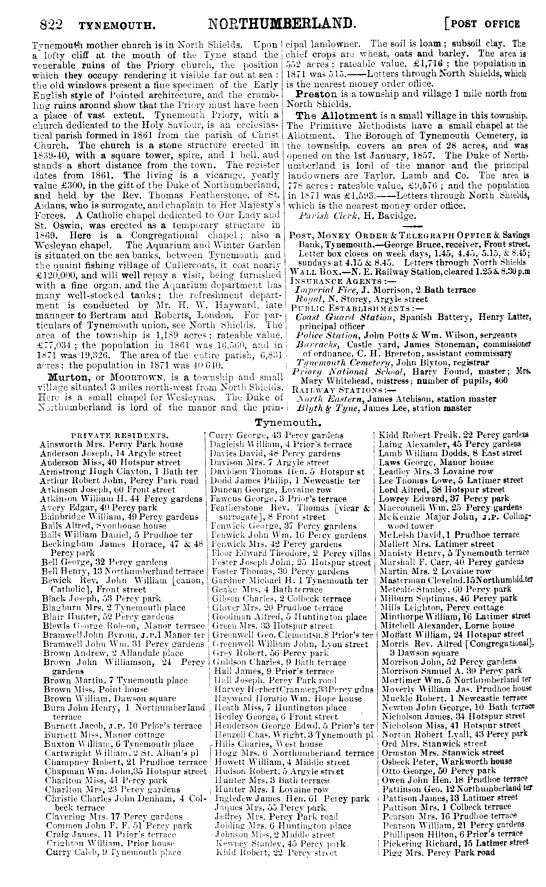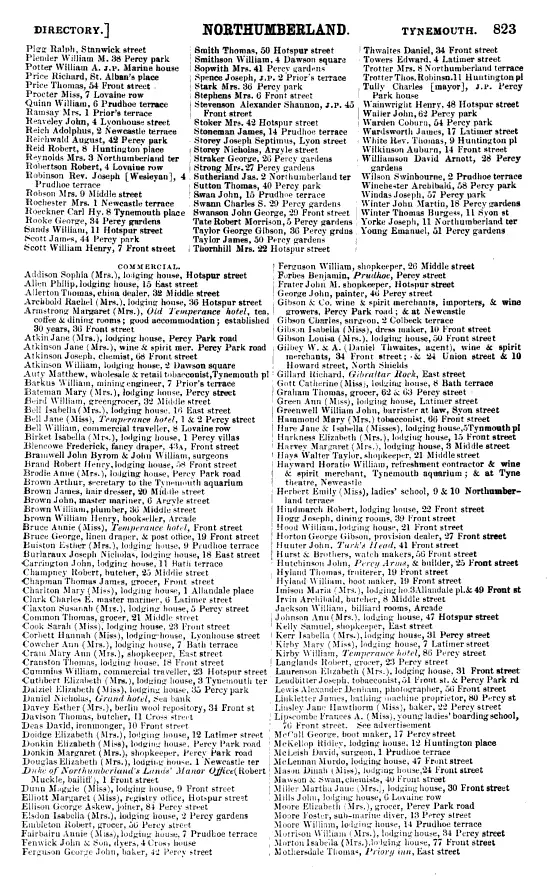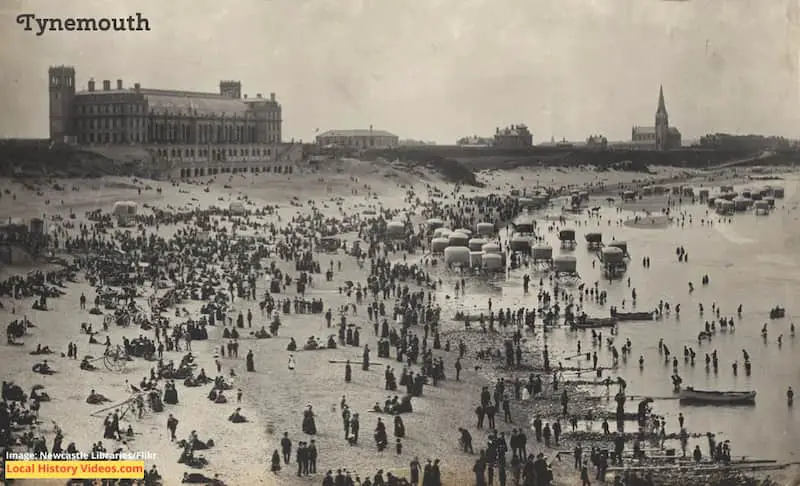Enjoy a glimpse of history through old images of Tynemouth, in North East England.
Swimming Gala in 1901
The famous Mitchell and Kenyon film archive includes 1901 footage of the Tynemouth Swimming Gala at the Haven. It’s worth watching to enjoy the costumes and moustaches alone!
Men swim in top hats, get quickly dressed into full outfits and hold open umbrellas ready for the next round of swimming, all watched on by bonneted ladies and their families sitting in nearby boats and crowds of people on the clifftop. Mr E. Miller, from North Shields, was the winner, and Mr R. Sopwith came second.
Next, divers jump from a platform designed by James Linkletter of Newcastle upon Tyne, which is fitted into a tall wooden ladder. The audience watches from the pier, which is still there today.
Tynemouth Swimming Gala in Haven, North Shields (1901) – BFI on YouTube
Bathing Pool in 1927
A home cine film was recorded as storms battered the coast in 1927. It shows waves crashing over the barrier into Tynemouth’s outdoor bathing pool, which had been built just two years before.
31b Wreck Cullercoats Storm Bathing Pool Tynemouth 1927 – P D on YouTube
Bathing Pool in 1967
Filmed in 1967 by Frank and Norah Wardle of Winlaton, this coliur home movie shows Tynemouth’s outdoor swimming pool busy with families enjoying the sunshine and water. There was plenty of seating for adults who didn’t want to go in the cold water, a building with changing rooms, and a pretty fountain.
Then the film moves to a fish shack selling kippers, winkles, and mussels, before a final photo of the derelict bathing pool on 5th November 2006.
Tynemouth Beach swimming pool uk 1967 updated – Frank Gillings on YouTube
1980s Tynemouth
Recorded in the mid 1980s, this home video opens at the Grand Hotel, showing diners, staff, various interiors, then views from the car park.
Next there’s a drive along the coast road, with a stop to look at the Priory and surrounding sights, and on to the lake and then the Park Hotel. Each of these scenes shows lots of buildings, people, and cars.
Tynemouth – Mid 1980s – Newcastle Upon Tyne & UK – Video from the past on YouTube
Historic Book
Extract from
A descriptive and historical guide to Tynemouth, with notices of North Shields, Seaton Delaval, and neighbouring antiquities
by William Sidney Gibson
Published 1849
Pages 136 – 143
THE TOWN OF TYNEMOUTH is no longer a village inhabited by tenants in husbandry, by workers in various handicraft trades, and by humble
villagers, clustering under the defence of the Prior’s Castle, and obtaining a livelihood in dependence upon the great ecclesiastical fraternity who were once its lords.
The prior, however faithfully and humbly he may have followed the rule of holy Benedict, was to the dwellers on his demesne not only an ecclesiastical father, a feudal superior, and dispenser of justice; but was the head of an establishment which, however spiritually-minded the monks may have been, gave employment to vast numbers of people, and maintained a considerable body of functionaries, serving men and dependents – the satellites of the monastic fraternity.
Many towns of England, which have long been opulent and important, owe their rise to monastic communities; to the trade which they fostered, the establishments which they maintained, and the resort to them of travellers and merchants.
In the halls of his Convent, the prior’s courts were periodically held; in his guest-house he entertained great numbers of persons who were often of the highest rank, and were attended by a considerable retinue.
To the exchequer and the granaries of his Convent no small portion of the produce of a vast district was brought; and from thence it was dispensed in hospitality to princes, ecclesiastics, and noblemen – in architectural and other works which gave employment to numerous artizans in the purchase of merchandize and manufactures that were brought thither from distant localities – and in daily charity to the
poor, who found succour at the Convent – gates .
So early as the reign of Edward I. a town or vill had thus sprung up at Tynemouth; and upon its green stood a cross, round which the tenants of its thatched cottages were wont to assemble.
From the steps of that cross, in days when newspapers were unknown, the art of printing undiscovered, and few if any persons except those of the religious orders could read – the death of the Sovereign, the accession of a new monarch, the triumph of the English arms, the acts of parliament, and other matters affecting the King’s lieges were announced to the listening rustics and tenants of Tynemouth – shire, or at least of the village and its neighbourhood .
The prior , as the reader will recollect , sought to raise Tynemouth to the importance of a market town , and for a brief period he held fair and market there ; and on his neighbouring quays claimed the privilege of free port in the Tyne .
Greatly would the gay and fashionable visitors to Tynemouth in the present day be astonished , could they behold the motley groups who were brought together on these occasions , the costume of the itinerant traders who resorted there , and the articles of commerce which found buyers .
We cannot doubt that , as long as the Priory existed , the vill of Tynemouth flourished , though its then humble dwellers dreamed not of parliamentary representation , nor of municipal privileges . But from the time when the great monastic establishment was suppressed , the village of Tynemouth , and even the prior’s adjacent town of North Shields , fell into obscurity ; and none could have supposed , even so
lately as the close of the seventeenth century , that its deserted hostelries and hearths would be succeeded by well built houses , and become the site of a populous town , annually the resort of hundreds who come to seek health and enjoy marine recreation, or to visit the interesting and venerable ruins of the once-magnificent Priory Church.
The parish of Tynemouth comprises the whole of the populous town and suburbs of North Shields , from which it is not far distant .
Tynemouth was constituted a borough by the act 2 William IV . c . 45 , and returns one member to parliament ; and at the present time a large number of the inhabitants seek the grant of municipal dignity to this
borough , and the enfranchisement of the shipping which floats in its harbour from the jurisdiction and the demands of the corporation of Newcastle .
The railway from that antient town has now been extended to Tynemouth , which is thus brought within thirty minutes’ journey from that great and populous mart of commercial industry and enterprize .
The principal object of interest after the ruins of the Priory and the Castle , is the Lighthouse – a lofty structure on the north side of the ground which was formerly the Priory garden . This important building was first erected by Colonel Villiers , governor of the Castle , late in the seventeenth century ; in 1775 his smaller structure gave place to
the present enlarged and substantial lighthouse .
The fixed light formerly exhibited at Tynemouth was superseded , some years ago , by a light which revolves upon the ingenious principle invented by the late Mr. Adam Walker , who was well known as the philosopher . It consists of an upright shaft which , by a curious arrangement of machinery moved by a kind of clock – work , revolves upon its axis in a given time , thus presenting the light periodically , and causing its brilliance to alternate with intervals of darkness .
Twenty – one parabolic reflectors made of copper , plated , in the focus of each of which an argand burner is fixed , are arranged on three frames , seven of these reflectors being placed in a pyramidal form on each frame . The cones of light thus produced are of remarkable brilliance , and from that quality and the great height of the lantern , which is upwards of 160 feet from the beach , the light is visible at an extraordinary distance ; while its appearance at regular intervals (which are more distinctly marked at sea than to a spectator on the land,) enables the mariner to identify the light observed .
This important lighthouse , which in its construction resembles a tower , so strong is its fabric and so commodious are its arrangements , was acquired some years ago by the corporation of the Trinity House in London , and is found amazingly productive .
The first light that was ever exhibited in Great Britain on Mr. Walker’s plan , was erected by him about 1791 in a lighthouse under the control of that corporation , situate on St. Mary’s Isle , one of the rocky and dangerous Seilly group , off ” the Land’s End ; ” apropos of which lighthouse it may be mentioned, that within its walls the present obliging and intelligent keeper of the lighthouse at Tynemouth was born.
The reflection of the rays from an arrangement of polished surfaces formed in the figure of the parabolic curve , and the application of the rotatory principle to lights on the sea coast , were found to be improvements so great that the revolving light soon came to be adopted on other stations without number ; but enormous as is the revenue produced by the light – dues in respect of the stations where the revolving light has been adopted , and great as is its value to the
royal navy and to the mercantile marine , it is worthy to be repeated here that neither the inventor in his life – time received , nor have any of his descendants received , the smallest reward for the completion and dedication to the public of this most important and distinctive light .
As a bathing – place , Tynemouth possesses many advantages . The Haven , in which neat and commodious baths have been established , has a sheltered and pleasant beach , around which the cliffs rise in the form of an amphitheatre , the area thus formed being perhaps 200 yards in width .
Numerous covered boats duly manned and bathing – machines duly womaned , await the visitors who prefer to plunge and sport in the invigorating tide which rolls from the wide ocean into this sheltered little bay ; while within the quadrangle of the Bath – house , every comfort is afforded to those who desire inclosed cold baths , shower – baths , or warm baths – a luxury from which the good monks of Tynemouth would doubtless have recoiled .
All these baths are supplied from the fresh salt sea , which is raised to the Bath house by a steam – engine .
Invalids may descend to the Bath – house or the beach in a carriage .
The charges for bathing are remarkably moderate , and the managers civil , attentive , and obliging .
On the promontory between this Haven ( which is called Prior’s Haven ) and the mouth of the Tyne , is a small battery called the Spanish Battery , which has succeeded to one that was formed there in the reign of Queen Elizabeth .
In it several guns can be mounted , and within the works there is a gunner’s residence .
An ancient sea – wall or rampart extended westward from this point along a part of the cliffs which stretch towards the town of North Shields , and are lofty throughout their range . This rampart gave strength to the defences of the Priory and Castle towards the river , and aided to insulate and defend its buildings from the approach of foes .
Upon a level spot , on the surface of these cliffs , and adjacent to the point of land on which the Spanish Battery stands , a fine statue of Admiral Lord Collingwood – one of the most distinguished Worthies of Northumberland – has been very recently erected .
It is unfortunately mounted upon a mean pedestal rising from a platform , which platform and pedestal are very unworthy of their commanding situation , and of those feelings towards the memory of this naval hero which are honourable to his native county .
The locality is such that to give this memorial grandeur of effect , a much larger mass , and a design very different from that of an exaggerated desk paper – weight , were required .
Between the Collingwood Memorial , and the chief street of Tynemouth , the old fish – ponds of the Convent , and trenches of the fortress extend .
The advantages of Tynemouth as a marine residence having been made cheaply and speedily accessible from all parts of the country , by the extension of a branch of the York , Newcastle , and Berwick Railway , to the very town of Tynemouth , it is not surprising that it should be a favourite place of resort for families residing in the neigh
bourhood ; and even for visitors of distinction from places remote .
Near the entrance of the town , some excellent houses have been newly built ; but the fine situation of Tynemouth , its advantages as a bathing – place , and the convenience with which provisions are obtained , not to mention the peculiar interest given to the spot by the ruins of the time – honoured Priory , and the historical associations which cluster around them seem to deserve more spirited and extensive provision for the improvement of the town .
A fine terrace might be advantageously raised on the sea – cliff northward of the town ; smooth walks might be provided ; and a library , reading – room , and bazaar , with some of the amusements usual in those establishments at other watering – places , would not fail to be most acceptable and attractive , and to relieve the monotony , which in dull weather especially , is felt at Tynemouth .
We should not omit to mention the fine sands that stretch between Tynemouth and Cullercotes – a fishing village , but much – frequented bathing – place , about a mile to the north of Tynemouth , -and also between Cullercotes and the head – land north of Whitley , and stretching towards Hartley . This sandy beach is broad , firm , and highly picturesque , more especially in the neighbourhood of Whitley :
where , though the cliffs have not majestic height , the sand stone is worn by the waves into forms of pleasing wildness .
In this vicinity , we may observe a well – known proof of the ancient convulsions of the globe , in the ” main , ” or ” great , ” or ” ninety – fathom dyke , ” which from this place traverses the coal – strata in a nearly vertical position in the general direction of north – north – east and south – south – west , passing probably into the formation underlying the coal – measures .
And in this vicinity , there are other phenomena not uninteresting to the geologist . The lower beds of the newer magnesian , or conglomerate limestone here , contain bivalves and entrochi , and alternate with shale , or slate – clay , on which substance one part of the bed rests ; another rests upon one of the sandstones of the coal series . The lime stone which here overlies both the coal strata and the ninety – fathom dyke , is in this place at the northern extremity of its western boundary . It is remarkable that although the dyke has traversed the coal , the limestone is not affected by it .
In the rocks northward of Tynemouth , there is a fine mineral ( chalybeate ) spring , which deservedly possesses great repute , and perhaps in antient days had the reputation of sanctity .
The road to this spring is on a gentle incline , and the sands below may likewise be reached without fatigue , and if the road were improved , by vehicles also.
The fine spacious beach or long sand between Tynemouth and Cullercotes is commanded by a battery for two guns , which was formed during the alarm of invasion by the French .
Below this battery the beach invites persons to bathe ; but there is a dangerous sweep of the sea during ebb – tide .
On the beach , a short distance from Tynemouth , and between the sheltered haven called Percy Bay and the next projecting cliffs to the north on the ridge of which the battery is formed , the rocks are bold and exceedingly varied .
From this beach , looking southward , the broad ocean stretching far beyond the range of vision , diver sified in the distance by the many vessels upon its ever heaving surface ; its long – swept waves rolling in , crested with sparkling foam , curling and breaking with a wild though
monotonous sound upon the wide rocky shore ; the bold precipitous cliff on which the Monastery and Castle stood ; the dignified and touching ruins of the Church ; the ramparts of the garrison ; and the lofty light – house on the edge of the promontory – all combine to form a picturesque and most interesting scene soothing and suggestive – as
well when the waves are tranquil , and nature , gilded by the mighty orb of day , ” in yellow lustre ” shines – as when all is reposing in more romantic beauty in the silvery lunar beams .
But when the profound and terrible expanse of ocean is agitated and blackened by the sweeping storm, and the sea-spray is carried over the lofty cliffs at whose base the impetuous breakers roar, the scene is full of impressive grandeur.
The Post Office Directory of Durham and Northumberland
by Kelly and Company
Published in 1879
The extract shown below from an old book published in 1879 tells us about some of the people, places and history connected with the following settlements and areas of this part of Northumberland:
- Tynemouth
- Murton/Moortown
- Preston
- The Allotment




You may also like to discover more about
More about Tyne & Wear
- Cowgate, Newcastle Upon Tyne: History in Old ImagesEnjoy a glimpse of history through old images of Cowgate, in Newcastle upon Tyne, Tyne & Wear, England, UK.
- Willington, North TynesideEnjoy a glimpse of history about Willington in North Tyneside, Tyne & Wear, North East England, UK.
- Newburn, Newcastle upon TyneEnjoy a glimpse of history about Newburn in Newcastle upon Tyne, Tyne & Wear, North East England, UK.
- Howdon, North TynesideEnjoy a glimpse of history about Howdon in North Tyneside, Tyne & Wear, North East England, UK.
- Fawdon, Newcastle upon TyneEnjoy a glimpse of history about Fawdon in Newcastle upon Tyne, Tyne & Wear, North East England, UK.
- Coxlodge, Newcastle upon TyneEnjoy a glimpse of history about Coxlodge in Newcastle upon Tyne, Tyne & Wear, North East England, UK.
- Earsdon, North TynesideEnjoy a glimpse of history about Earsdon in North Tyneside, Tyne & Wear, North East England, UK.
- Dinnington, Newcastle upon TyneEnjoy a glimpse of history about Dinnington in Newcastle upon Tyne, Tyne & Wear, North East England, UK.
- Chirton, North East EnglandEnjoy a glimpse of history about Chirton in North Shields, Tyne & Wear, North East England, UK.
- Usworth, Tyne & WearEnjoy a glimpse of history about Usworth in Washington, Tyne & Wear, England, UK.





